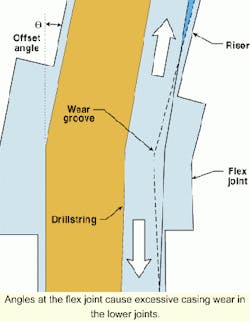The consequences of extreme riser wear at the flex joint increase in severity as drilling water depths increase. Like a number of other phenomena, the extreme depths and the tough environment of deepwater drilling exacerbate this problem.
While the US Minerals Management Service (MMS), which regulates activities in the Gulf of Mexico, allows drilling to continue as long as the riser is within 2° of vertical at the flex joint, recent research has shown that a variation of less than 1° can have devastating effects on the lower 1-2 riser joints.
Angles at the flex joint cause excessive casing wear in the lower joints.
Maurer Engineering conducted research into this growing problem. Tom Prosser, Project Manager with Maurer Engineering, cites cases where deepwater riser joints have worn completely through and others which resulted in heavily grooved flex joints. In one, Prosser said a new lower riser joint was worn through to the point of bursting, in only 150 hours of use.
Expensive to pull
What makes the wear problem even more disturbing is the fact that the lower riser joints are the most expensive to pull for inspection or replacement. Prosser said there are a number of contributing elements that cause this problem.
The angle of the riser and inadequate tensioning can initiate the wear, but tool joints sheathed in tungsten carbide have a rough outer surface, which speeds the wear process. In the past, tungsten carbide was commonly used as a hardmetal component to protect the tool joint from wear and damage, but Prosser said alternative materials are now available to protect the lower riser joints from wear.
Other factors are the currents and temperatures in deepwater. Greater depths and surface currents hamper stationkeeping. In addition to pushing the drilling vessel off station, currents bend the riser string in varying directions at different depths. The colder temperatures near the deepwater seafloor actually make the riser material more susceptible to wear, Prosser said.
In tests, samples of X-80 steel used in riser joints were compared to N-80 steel material used in casing. It was found that the riser material wore 5-15 times faster than the casing. Prosser said he believes the way riser joints are constructed could be significant in explaining this difference in wear characteristics.
Although seamless riser has been used in the past, current riser material, such as X-80, is flat sheet steel that is rolled into a tubular shape and welded down a seam. Casing, on the other hand, is made of seamless or welded construction and is externally and internally heat treated. It appears that this rolling, welding, and limited heat treatment of the riser may alter the metallurgy of the riser joint, making it internally more prone to wear than a similar string of casing.
Blow through
When a lower riser joint becomes too worn, it can no longer contain the extreme pressures from the mud column and will burst. This will result in a loss of returns to the surface. When a riser joint fails, fluid in the entire deepwater riser must be evacuated, disconnected, and pulled, so the joint can be replaced. The joint itself is expensive to replace and the lost drilling mud is also valuable, but that is just a fraction of the true cost of this failure. Depending on whether this is a bare joint or one encased in a syntactic foam module, the pulling and replacement can cost the drilling unit several days of drilling.
"It's the downtime that kills you," Prosser said. Because the wear occurs rapidly and on the inside of the lower joint it is difficult to detect, unless metal filings or particles are detected in the return mud screens, or a blow through causes a loss of returns. By then, the damage is already done.
Casing strings exposed to excessive wear are subject to blow through.
Riser joints are routinely pulled and inspected for wear, however, these lower joints are the most expensive, in terms of downtime, to pull, inspect, and rotate in the string to reduce potential wear. Even in a case where the stationkeeping of the deepwater rig is exceptionally precise, and the riser is kept within 1° of vertical over the well, Prosser said a slight variation in the verticality of the subsea wellhead could increase the angle with the tool joint and cause a groove to form in the lower riser joint. Once the groove is started, it is difficult to halt the wear. Prosser said even a slight groove can draw the drill string back into it, even if the angle is corrected.
Causes and solutions
While the results of this wear are easily documented, Prosser said it is more difficult to pinpoint exactly what is occurring inside the riser prior to the blow-through incident. This is a
significant point of focus for the recently announced DEA-137, "Deepwater Riser Wear Technology" project.
Maurer Engineering's software program, Cwear, allows users to profile the burst and collapse of a riser joint and replicate what is happening inside the riser. This software makes it possible to evaluate various alternative materials and operating techniques to determine the best solution for this problem.
Prosser said alternative materials have been considered for riser joint construction. Joints made from titanium offer a number of advantages. Titanium is more flexible, 30% lighter, and much stronger than steel. The lightweight and flexibility of an all-titanium riser string means it would flex more than a conventional string. A drilling riser string made entirely from titanium also would have its own drawbacks.
A titanium riser would be very susceptible to wear, unless it is internally shielded. To date, the most effective liner has been 0.25-0.50 in. thick rubber sheeting. This material has been stretched and glued to the interior of the riser joints. During drilling operations the rubber will compress slightly then return to normal state, but it can be chipped or gouged from the riser by constant contact with the drill string.
Rubber lining
Reports from Norway's Heidrun tension leg platform, which has used a titanium drill string, indicate the rubber lining can be repaired by technicians on board the drilling vessel with satisfactory results. Other types of liners are also under investigation.
While a properly lined titanium riser string would be less susceptible to wear, it would also flex a lot more than a steel string. There is a potential for the whipping motion from the riser string to damage the wellhead. Titanium also is much more expensive than steel. Prosser said a flex joint would not used with such a system.
Instead, a tapered stress joint would connect the riser to the wellhead. This eliminates the shoulders and other outcroppings that may lead to excessive wear near the flex joint, but the flexibility of the titanium taper unit could also cause wear to occur. To reduce the cost and the weight of this riser string, the lower three joints could be titanium. This would still allow the flex joint to be eliminated and would reduce the wear. These three joints would be rotated in position to further guard against excessive wear.
These and other alternatives being considered in a proposed joint industry project (JIP) Maurer has presented to the industry. In addition to considering alternative materials such as composites for riser construction and the development of mixed hybrid strings, the JIP will study coatings for the inside of steel, titanium, and composite risers that could protect the lower joints from wear.
Smooth, yet hard, materials are being introduced and studied which take the place of tungsten carbide and protect both the tool joint and the riser from excessive wear. Prosser said the study is actively seeking participants. The JIP is scheduled to run for two years and will terminate in May of 2002.




